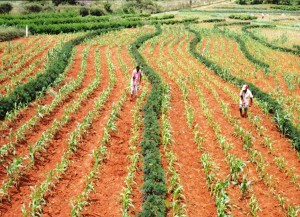The right trees, coupled with the right varieties of crops, rural advisory services, and a supportive policy environment can have a huge impact on crop yields, nutrition and income in Africa. And because smallholder farmers feed and nourish most of Africa’s 1 billion population, this is where we must start.
Agroforestry systems in Africa range from open parkland assemblages, home gardens, mixtures of trees with one or several crops, and trees planted in hedges and boundaries of fields and farms. Thanks to a rich body of science-based knowledge that brings the best in ‘agro’ and ‘forest’ together, farmers can select the right tree and crop associations for the right place. Well designed agroforestry systems provide benefits that cannot be attained from monocrops.
African farmers have the most agroforestry species to choose from out of all developing countries; according to the Agroforestree Database at least 1,141 species are known to provide functions of importance to smallholders for promoting food and nutritional security. Among these are fertilizer trees, fruit and nut trees, as well as nutritious fodder trees and shrubs, which lead to higher yields for dairy farmers.
Agroforestry using fertilizer trees has been proven to raise and stabilize maize yields. between 2007 and 2011 ICRAF and partners implemented the Malawi Agroforestry Food Security Programme funded by Irish Aid, reaching about 180,000 farmers. The programme involved introducing fertilizer, fruit, and fodder trees and shrubs into smallholder farms. By the end of the intervention maize yields, food-secure months per year, and fruit availability had changed for the better in a vast majority of households practicing agroforestry. And across hundreds of thousands of hectares of the Sahelian region of Africa, yields of grains, ground nut and cotton have improved when grown under or near the fertilizer tree Faidherbia.





